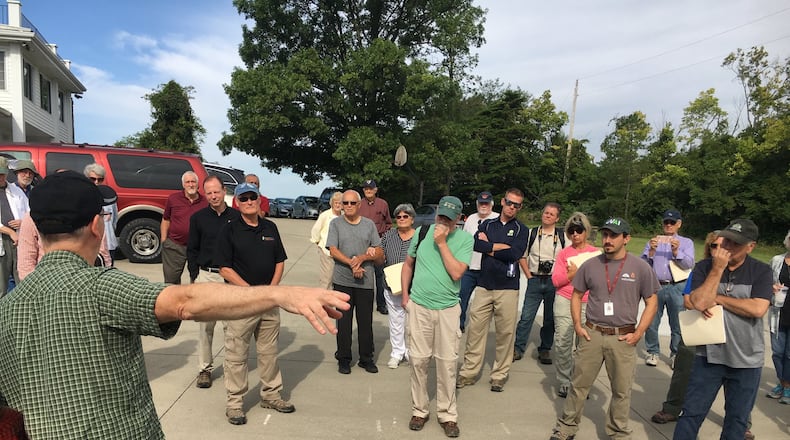He envisions signage through the area explaining what people are seeing, and possibly a visitor’s center featuring a gallery of artifacts found on the site.
“But really, our focus is keeping the earthwork preserved,” he said. “And if that means that at some point we’re not able to go through and start digging up, that’s fine.”
Archaeologists, historians and others donated money to buy the land, which was owned by the late Hamilton dermatologist Dr. Louis Luke Barich, at a September estate auction. Those behind the purchase feared the cultural treasure would be plowed over in creation of a housing subdivision.
The property, containing the “Fortified Hill” earthworks that occupy almost 17 acres, handed over in December to be managed by Pyramid Hill, so things are in very early stages. FitzGibbons emphasized the new caretakers plan to move carefully.
“There’s been such an outpouring of public interest, and to be honest, this is something that is really important to a lot of people, so I think it would be a disservice if Pyramid Hill just said, ‘OK, great. We have it. Let’s just put it out there for everybody to come out and see it, and then everybody gets out there, and people don’t really know what they’re looking at,” he said.
“It’ll be something that I think will be a huge advantage to Hamilton, Butler County and Greater Cincinnati.”
FitzGibbons believes leaders of the effort in the next few months will formally ask for public input about what they would like to see at the park.
“One of the things we’re very adamant about is because there’s so much public interest, we will be announcing soon how we’re going to take in the public opinion,” FitzGibbons said. “But at the end of the day, when you do take in public opinion, you have five people saying one thing, and five people saying the other.”
What are some next steps?
“Our goal is to open in phases,” he said. “I think we can have something realistically at some point in 2021. That’s the initial kind-of welcoming people — maybe not open as a park, but engaging the community and working with people to help get the park ready. Kind of like getting Boy Scouts out there, getting volunteers to come out and help clean up, things like that.”
He hopes it can be open as a park “shortly after that,” maybe in 2022.
“We have to make sure our plans of making it open to the public align with doing it the right way,” he said. “That means not disturbing the earthwork when we clear plants. It also means clearing plants ethically — not going out and just getting rid of everything (but eliminating honeysuckle and other “invasive species). We want it to be a natural site…. Maybe leaving some of the Ohio-native plants.”
“There’s just going to be a lot of planning and trying to figure how that’s actually going to look, and honestly how are we going to initiate these plans?” he said.
The earthworks are believed to have been built by the Hopewell people, although experts aren’t sure their exact purpose.
While they may be similar to the Fort Ancient Earthworks and other Native American sites in Ohio likely to be considered by the U.S. Department of Interior in 2023 for UNESCO World Heritage Status, it’s highly unlikely the Ross Township land will be part of that application, because that would require officials to take several steps backward in that long-sought effort that could significantly increase tourism to those sites, Jen Altman, the Ohio History Connection’s director of world heritage told the Journal-News.
“What they always tell us is ‘We want the strongest possible application,” Altman said. It’s possible that after the other earthworks receive world-heritage status — if they do — the Butler County site could be included, but even that would require the difficult accomplishment of demonstrating Fortified Hill significantly adds to what the other sites already offer to the public, she said.
Even without the UNESCO status, the Fortified Hill property could benefit from UNESCO status, especially for visitors from Greater Cincinnati, who life farther from the other Ohio locations, such as Chillicothe.
“The Hopewell landscape was all over southern Ohio,” she said. “So no matter which ones are technically on the nomination, let’s make a great experience of the whole place.”
About the Author
